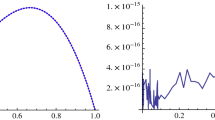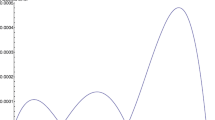Abstract
In this paper, a simple numerical method is proposed for solving singularly perturbed boundary layers problems exhibiting twin boundary layers. The method avoids the choice of fitted meshes. Firstly the original problem is transformed into a new boundary value problem whose solution does not change rapidly by a proper variable transformation; then the transformed problem is solved by using the reproducing kernel method. Two numerical examples are given to show the effectiveness of the present method.


Similar content being viewed by others
References
Natesan, S., Jayakumar, J., Vigo-Aguiar, J.: Parameter uniform numerical method for singularly perturbed turning point problems exhibiting boundary layers. J. Comput. Appl. Math. 158, 121–134 (2003)
Kadalbajoo, M.K., Arora, P., Gupta, V.: Collocation method using artificial viscosity for solving stiff singularly perturbed turning point problem having twin boundary layers. Comput. Math. Appl. 61, 1595–1607 (2011)
Rai, P., Sharma, K.K.: Nnmerical method for singularly perturbed differential-difference equation with turning point. Int. J. Pure Appl. Math. 73, 451–470 (2011)
Rai, P., Sharma, K.K.: Numerical study of singularly perturbed differential-difference equation arising in the modeling of neuronal variability. Comput. Math. Appl. 63, 118–132 (2012)
Rai, P., Sharma, K.K.: Numerical analysis of singularly perturbed delay differential turning point problem. Appl. Math. Comput. 218, 3483–3498 (2011)
Phaneendra, K., Rakmaiah, S., Chenna Krishna Reddy, M.: Numerical treatment of singular perturbation problems exhibiting dual boundary layers. Ain Shams Eng. J. (2015). doi:10.1016/j.asej.2015.02.012
Becher, S., Roos, H.-G.: Richardson extrapolation for a singularly perturbed turning point problem with exponential boundary layers. J. Comput. Appl. Math. 290, 334–351 (2015)
Geng, F.Z., Qian, S.P.: Reproducing kernel method for singularly perturbed turning point problems having twin boundary layers. Appl. Math. Lett. 26, 998–1004 (2013)
Aronszajn, N.: Theory of reproducing kernels. Trans. Am. Math. Soc. 68, 337–404 (1950)
Geng, F.Z., Cui, M.G.: Solving a nonlinear system of second order boundary value problems. J. Math. Anal. Appl. 327, 1167–1181 (2007)
Cui, M.G., Geng, F.Z.: Solving singular two-point boundary value problem in reproducing kernel space. J. Comput. Appl. Math. 205, 6–15 (2007)
Cui, M.G., Lin, Y.Z., et al.: Nonlinear Numerical Analysis in Reproducing Kernel Space. Nova Science Publishers, Inc., Commack (2009)
Li, X.Y., Wu, B.Y.: Error estimation for the reproducing kernel method to solve linear boundary value problems. J. Comput. Appl. Math. 243, 10–15 (2013)
Li, X.Y., Wu, B.Y.: A continuous method for nonlocal functional differential equations with delayed or advanced arguments. J. Math. Anal. Appl. 409, 485–493 (2014)
Wang, W.Y., Yamamoto, M., Han, B.: Numerical method in reproducing kernel space for an inverse source problem for the fractional diffusion equation. Inverse Probl. 29, 1–15 (2013)
Wang, W.Y., Han, B., Yamamoto, M.: Inverse heat problem of determining time-dependent source parameter in reproducing kernel space. Nonlinear Anal. Real World Appl. 14, 875–887 (2013)
Wang, Y., Su, L., Cao, X., Li, X.: Using reproducing kernel for solving a class of singularly perturbed problems. Comput. Math. Appl. 61, 421–430 (2011)
Jiang, W., Lin, Y.Z.: Representation of exact solution for the time-fractional telegraph equation in the reproducing kernel space. Commun. Nonlinear Sci. Numer. Simulat. 16, 3639–3645 (2011)
Inc, M., Akgül, A.: Numerical solution of seventh-order boundary value problems by a novel method. Abstr. Appl. Anal. 2014, 1–9 (2014)
Mohammadi, M., Mokhtari, R.: Solving the generalized regularized long wave equation on the basis of a reproducing kernel space. J. Comput. Appl. Math. 235, 4003–4014 (2011)
Akram, G., Ur Rehman, H.: Numerical solution of eighth order boundary value problems in reproducing Kernel space. Numer. Algorithms 62, 527–540 (2013)
Arqub, O.A., Al-Smadi, M., Shawagfeh, N.: Solving Fredholm integro-differentialequations using reproducing kernel Hilbert space method. Appl. Math. Comput. 219, 8938–8948 (2013)
Abu, O. A.: Adaptation of reproducing kernel algorithm for solving fuzzy Fredholm–Volterra integrodifferential equations. Neural Comput. Appl. (2015). doi:10.1007/s00521-0152110-x
Arqub, O.A., Mohammed, A.S., Momani, S., Hayat, T.: Numerical solutions of fuzzy differential equations using reproducing kernel Hilbert space method. Soft Comput. (2015). doi:10.1007/s00500-0151707-4
Momani, S., Arqub, O.A., Hayat, T., Al-Sulami, H.: A computational method for solving periodic boundary value problems for integro-differential equations of Fredholm-Volterra type. Appl. Math. Comput. 240, 229–239 (2014)
Abbasbandy, S., Azarnavid, B., Alhuthali, M.S.: A shooting reproducing kernel Hilbert space method for multiple solutions of nonlinear boundary value problems. J. Comput. Appl. Math. 279, 293–305 (2015)
Ketabchi, R., Mokhtari, R., Babolian, E.: Some error estimates for solving Volterra integral equations by using the reproducing kernel method. J. Comput. Appl. Math. 273, 245–250 (2015)
Ghasemi, M., Fardi, M., Ghaziani, R.K.: Numerical solution of nonlinear delay differential equations of fractional order in reproducing kernel Hilbert space. Appl. Math. Comput. 268, 815–831 (2015)
Geng, F.Z., Qian, S.P.: Modified reproducing kernel method for singularly perturbed boundary value problems with a delay. Appl. Math. Model. 39, 5592–5597 (2015)
Acknowledgments
The work was supported by the National Natural Science Foundation of China (Nos. 11201041, 11026200), the Special Funds of the National Natural Science Foundation of China (No. 11141003) and Qing Lan Project of Jiangsu Province.
Author information
Authors and Affiliations
Corresponding author
Rights and permissions
About this article
Cite this article
Geng, F.Z., Qian, S.P. A new numerical method for singularly perturbed turning point problems with two boundary layers based on reproducing kernel method. Calcolo 54, 515–526 (2017). https://doi.org/10.1007/s10092-016-0196-x
Received:
Accepted:
Published:
Issue Date:
DOI: https://doi.org/10.1007/s10092-016-0196-x




